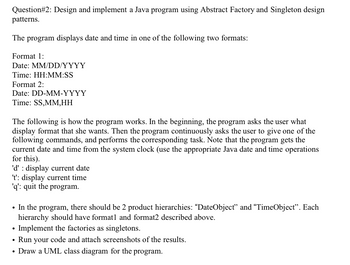
EBK JAVA PROGRAMMING
9th Edition
ISBN: 9781337671385
Author: FARRELL
Publisher: CENGAGE LEARNING - CONSIGNMENT
expand_more
expand_more
format_list_bulleted
Question

Transcribed Image Text:Question#2: Design and implement a Java program using Abstract Factory and Singleton design
patterns.
The
program displays date and time in one of the following two formats:
Format 1:
Date: MM/DD/YYYY
Time: HH:MM:SS
Format 2:
Date: DD-MM-YYYY
Time: SS,MM,HH
The following is how the program works. In the beginning, the program asks the user what
display format that she wants. Then the program continuously asks the user to give one of the
following commands, and performs the corresponding task. Note that the program gets the
current date and time from the system clock (use the appropriate Java date and time operations
for this).
'd' display current date
't': display current time
'q': quit the program.
• In the program, there should be 2 product hierarchies: "DateObject” and “TimeObject”. Each
hierarchy should have format and format2 described above.
•
Implement the factories as singletons.
• Run your code and attach screenshots of the results.
• Draw a UML class diagram for the program.
Expert Solution
This question has been solved!
Explore an expertly crafted, step-by-step solution for a thorough understanding of key concepts.
Step by stepSolved in 2 steps with 2 images

Knowledge Booster
Similar questions
- Programming language is C#arrow_forwardWhen you borrow money to buy a house, a car, or for some other purpose, you repay the loan by making periodic payments over a certain period of time. Of course, the lending company will charge interest on the loan. Every periodic payment consists of the interest on the loan and the payment toward the principal amount. To be specific, suppose that you borrow $1,000 at an interest rate of 7.2% per year and the payments are monthly. Suppose that your monthly payment is $25. Now, the interest is 7.2% per year and the payments are monthly, so the interest rate per month is 7.2/12 = 0.6%. The first months interest on $1,000 is 1000 0.006 = 6. Because the payment is $25 and the interest for the first month is $6, the payment toward the principal amount is 25 6 = 19. This means after making the first payment, the loan amount is 1,000 19 = 981. For the second payment, the interest is calculated on $981. So the interest for the second month is 981 0.006 = 5.886, that is, approximately $5.89. This implies that the payment toward the principal is 25 5.89 = 19.11 and the remaining balance after the second payment is 981 19.11 = 961.89. This process is repeated until the loan is paid. Write a program that accepts as input the loan amount, the interest rate per year, and the monthly payment. (Enter the interest rate as a percentage. For example, if the interest rate is 7.2% per year, then enter 7.2.) The program then outputs the number of months it would take to repay the loan. (Note that if the monthly payment is less than the first months interest, then after each payment, the loan amount will increase. In this case, the program must warn the borrower that the monthly payment is too low, and with this monthly payment, the loan amount could not be repaid.)arrow_forwardIndicate whether each of the following C# programming language identifiers is legal or illegal. If it is legal, indicate whether it is a conventional identifier for a class. electricBill ElectricBill Electric bill Static void #ssn Ay56we Theater_Tickets 212AreaCode heightInCentimeters Zip23891 Voidarrow_forward
- (Numerical) Write a program that tests the effectiveness of the rand() library function. Start by initializing 10 counters to 0, and then generate a large number of pseudorandom integers between 0 and 9. Each time a 0 occurs, increment the variable you have designated as the zero counter; when a 1 occurs, increment the counter variable that’s keeping count of the 1s that occur; and so on. Finally, display the number of 0s, 1s, 2s, and so on that occurred and the percentage of the time they occurred.arrow_forward(Simulation) Write a program to simulate the roll of two dice. If the total of the two dice is 7 or 11, you win; otherwise, you lose. Embellish this program as much as you like, with betting, different odds, different combinations for win or lose, stopping play when you have no money left or reach the house limit, displaying the dice, and so forth. (Hint: Calculate the dots showing on each die with the expression dots=(int)(6.0randomnumber+1), where the random number is between 0 and 1.)arrow_forward
arrow_back_ios
arrow_forward_ios
Recommended textbooks for you
 EBK JAVA PROGRAMMINGComputer ScienceISBN:9781337671385Author:FARRELLPublisher:CENGAGE LEARNING - CONSIGNMENT
EBK JAVA PROGRAMMINGComputer ScienceISBN:9781337671385Author:FARRELLPublisher:CENGAGE LEARNING - CONSIGNMENT Microsoft Visual C#Computer ScienceISBN:9781337102100Author:Joyce, Farrell.Publisher:Cengage Learning,
Microsoft Visual C#Computer ScienceISBN:9781337102100Author:Joyce, Farrell.Publisher:Cengage Learning, EBK JAVA PROGRAMMINGComputer ScienceISBN:9781305480537Author:FARRELLPublisher:CENGAGE LEARNING - CONSIGNMENT
EBK JAVA PROGRAMMINGComputer ScienceISBN:9781305480537Author:FARRELLPublisher:CENGAGE LEARNING - CONSIGNMENT C++ for Engineers and ScientistsComputer ScienceISBN:9781133187844Author:Bronson, Gary J.Publisher:Course Technology Ptr
C++ for Engineers and ScientistsComputer ScienceISBN:9781133187844Author:Bronson, Gary J.Publisher:Course Technology Ptr C++ Programming: From Problem Analysis to Program...Computer ScienceISBN:9781337102087Author:D. S. MalikPublisher:Cengage LearningProgramming Logic & Design ComprehensiveComputer ScienceISBN:9781337669405Author:FARRELLPublisher:Cengage
C++ Programming: From Problem Analysis to Program...Computer ScienceISBN:9781337102087Author:D. S. MalikPublisher:Cengage LearningProgramming Logic & Design ComprehensiveComputer ScienceISBN:9781337669405Author:FARRELLPublisher:Cengage

EBK JAVA PROGRAMMING
Computer Science
ISBN:9781337671385
Author:FARRELL
Publisher:CENGAGE LEARNING - CONSIGNMENT

Microsoft Visual C#
Computer Science
ISBN:9781337102100
Author:Joyce, Farrell.
Publisher:Cengage Learning,

EBK JAVA PROGRAMMING
Computer Science
ISBN:9781305480537
Author:FARRELL
Publisher:CENGAGE LEARNING - CONSIGNMENT

C++ for Engineers and Scientists
Computer Science
ISBN:9781133187844
Author:Bronson, Gary J.
Publisher:Course Technology Ptr

C++ Programming: From Problem Analysis to Program...
Computer Science
ISBN:9781337102087
Author:D. S. Malik
Publisher:Cengage Learning

Programming Logic & Design Comprehensive
Computer Science
ISBN:9781337669405
Author:FARRELL
Publisher:Cengage